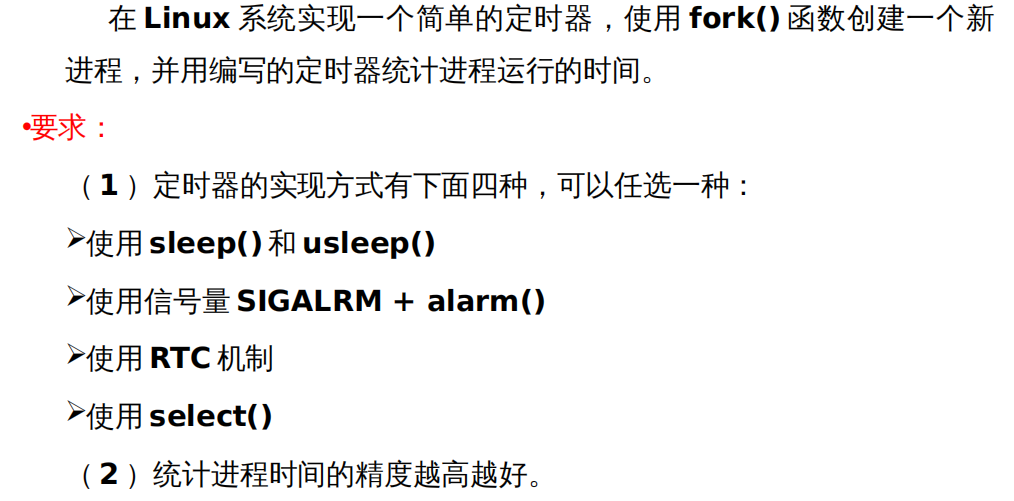Linux定时器
- 题目
- 相关概念
- setitimer
- 计时器
- 源码
题目

相关概念
setitimer
Linux 系统为每个进程提供三个间隔计时器,每个计时器在不同的时间域递减。当任何计时器
到期时,向进程发送一个信号,然后计时器(可能)重新启动。
ITIMER_REAL 定时器运行的时间就是总运行时间,
ITIMER_PROF 定时器的运行时间就是 CPU 花在该进程上的所有时间。
ITIMER_VIRTUAL定时器运行的时间是进程在用户模式的运行时间。
ITIMER_PROF 定时器的运行时间减去ITIMER_VIRTUAL 定时器的运行时间
就是进程在核心模式的运行时间。
计时器
/*参数 结构体 itimerval */
struct itimerval {
struct timeval it_interval; /* 第一次触发定时器后,每次触发定时器周期时间值 */
struct timeval it_value; /* 第一次触发定时器时间值 */
};
struct timeval {
time_t tv_sec; /* seconds */
suseconds_t tv_usec; /* microseconds */
}
int setitimer(int which, const struct itimerval *new_value, struct itimerval *old_value);
参数 which:(可选值如下)
ITIMER_REAL: 以系统真实的时间来计算,它送出SIGALRM信号。
ITIMER_VIRTUAL:以该进程在用户态下花费的时间来计算,它送出SIGVTALRM信号。
ITIMER_PROF: 以该进程在用户态下和内核态下所费的时间来计算。它送出SIGPROF信号。
参数 *new_value: 用于对定时器的时间进行配置,即配置什么时候触发定时器
参数 *old_value: 获取上一次配置的时间参数值
源码
#include <stdio.h>
#include <string.h>
#include <unistd.h>
#include <sys/ipc.h>
#include <sys/shm.h>
#include<signal.h>
#include <stdlib.h>
#include<time.h>
#include<sys/time.h>
#include <fcntl.h>
#include <limits.h>
#include <sys/types.h>
#include <sys/wait.h>
static void par_sig(int signo); /*父进程的信号处理函数*/
static void c1_sig(int signo); /*子进程 1 的信号处理函数*/
/*用于分别记录父,子 1 进程 real time 过的总秒数*/
static long p_realt_secs=0,c1_realt_secs=0;
/*用于分别记录父,子 1进程 virtual time 过的总秒数*/
static long p_virtt_secs=0, c1_virtt_secs=0;
/*用于分别记录父,子 1 进程 proft time 过的总秒数*/
static long p_proft_secs=0,c1_proft_secs=0;
/*用于分别取出父,子 1 进程的 real timer 的值*/
static struct itimerval p_realt,c1_realt;
/*用于分别取出父,子 1,子 2 进程的 virtual timer 的值*/
static struct itimerval p_virtt,c1_virtt;
/*用于分别取出父,子 1进程的 proft timer 的值*/
static struct itimerval p_proft,c1_proft;
int main()
{
long unsigned fib=0;
pid_t pid1,pid2;
unsigned int fibarg=39;
int status;
struct itimerval v;
long moresec,moremsec,t1,t2;
pid1=fork();
if(pid1==0)
{
/*设置子进程 1 的信号处理函数和定时器初值*/
signal(SIGALRM,c1_sig);
signal(SIGVTALRM,c1_sig);
signal(SIGPROF,c1_sig);
v.it_interval.tv_sec=10;
v.it_interval.tv_usec=0;
v.it_value.tv_sec=10;
v.it_value.tv_usec=0;
setitimer(ITIMER_REAL,&v,NULL);
setitimer(ITIMER_VIRTUAL,&v,NULL);
setitimer(ITIMER_PROF,&v,NULL);
/*
operation
在此处可以添加任意操作,可以统计此进程的时间
*/
/*取出子进程 1 的定时器值*/
getitimer(ITIMER_PROF,&c1_proft);
getitimer(ITIMER_REAL,&c1_realt);
getitimer(ITIMER_VIRTUAL,&c1_virtt);
/*通过定时器的当前值和各信号发出的次数计算子进程 1 总共用的 real time,cpu
time,user time 和 kernel time。moresec 和 moremsec 指根据定时器的当前值计算
出的自上次信号发出时过去的 real time,cpu time,user time 和 kernel time。计算
kernel time 时,moresec 和 moremsec 为 kernel time 的实际秒数+毫秒数*/
moresec=9-c1_realt.it_value.tv_sec;
moremsec= (1000000-c1_realt.it_value.tv_usec)/1000;
printf("Child 1 fib=%ld , real time=%ld sec,%ldmsecn",fib,c1_realt_secs+moresec,moremsec);
moresec=9-c1_proft.it_value.tv_sec;
moremsec=(1000000-c1_proft.it_value.tv_usec)/1000;
printf("Child 1 fib=%ld , cpu time=%ld sec,%ldmsecn",fib,c1_proft_secs+moresec,moremsec);
moresec=9-c1_virtt.it_value.tv_sec;
moremsec=(1000000-c1_virtt.it_value.tv_usec)/1000;
printf("Child 1 fib=%ld , user time=%ld sec,%ldmsecn",fib,c1_virtt_secs+moresec,moremsec);
t1=(9-c1_proft.it_value.tv_sec)*1000+(1000000-c1_proft.it_value.tv_usec)/1000+c1_proft_secs*10000;
t2=(9-c1_virtt.it_value.tv_sec)*1000+(1000000-c1_virtt.it_value.tv_usec)/1000+c1_virtt_secs*10000;
moresec=(t1-t2)/1000;moremsec=(t1-t2)%1000;
printf("Child 1 fib=%ld , kernel time=%ld sec,%ld msecn",fib,moresec,moremsec);
fflush(stdout);
exit(0);
}
else
{
/*设置父进程的信号处理函数和定时器初值*/
signal(SIGALRM,par_sig);
signal(SIGVTALRM,par_sig);
signal(SIGPROF,par_sig);
v.it_interval.tv_sec=10;
v.it_interval.tv_usec=0;
v.it_value.tv_sec=10;
v.it_value.tv_usec=0;
setitimer(ITIMER_REAL,&v,NULL);
setitimer(ITIMER_VIRTUAL,&v,NULL);
setitimer(ITIMER_PROF,&v,NULL);
/*
operation
在此处可以添加任意操作,可以统计此进程的时间
*/
/*取出父进程的定时器值*/
getitimer(ITIMER_PROF,&p_proft);
getitimer(ITIMER_REAL,&p_realt);
getitimer(ITIMER_VIRTUAL,&p_virtt);
/*通过定时器的当前值和各信号发出的次数计算子进程 1 总共用的
real time,cpu time,user time 和 kernel time。moresec 和 moremsec 指根据
定时器的当前值计算出的自上次信号发出时过去的 real time,cpu
time,user time 和 kernel time。计算 kernel time 时,moresec 和 moremsec
为 kernel time 的实际秒数+毫秒数*/
moresec=9-p_realt.it_value.tv_sec;
moremsec=(1000000-p_realt.it_value.tv_usec)/1000;
printf("Parent fib=%ld , real time=%ld sec,%ldmsecn",fib,p_realt_secs+moresec,moremsec);
moresec=9-p_proft.it_value.tv_sec;
moremsec=(1000000-p_proft.it_value.tv_usec)/1000;
printf("Parent fib=%ld , cpu time=%ld sec,%ldmsecn",fib,p_proft_secs+moresec,moremsec);
moresec=9-p_virtt.it_value.tv_sec;
moremsec=(1000000-p_virtt.it_value.tv_usec)/1000;
printf("Parent fib=%ld , user time=%ld sec,%ldmsecn",fib,p_virtt_secs+moresec,moremsec);
t1=(9-p_proft.it_value.tv_sec)*1000+(1000000-p_proft.it_value.tv_usec)/1000+p_proft_secs*10000;
t2=(9-p_virtt.it_value.tv_sec)*1000+(1000000-p_virtt.it_value.tv_usec)/1000+p_virtt_secs*10000;
moresec=(t1-t2)/1000;
moremsec=(t1-t2)%1000;
printf("Parent fib=%ld , kernel time=%ld sec,%ldmsecn",fib,moresec,moremsec);
fflush(stdout);
waitpid(0,&status,0);
waitpid(0,&status,0);
exit(0);
printf("this line should never be printedn");
}
}
/*父进程信号处理函数;每个 timer 过 10 秒减为 0,激活处理函数一次,相应的计数器加 10*/
static void par_sig(int signo)
{
switch(signo)
{
case SIGALRM:
p_realt_secs+=10;
break;
case SIGVTALRM:
p_virtt_secs+=10;
break;
case SIGPROF:
p_proft_secs+=10;
break;
}
}
/*子进程 1 的信号处理函数,功能与父进程的信号处理函数相同*/
static void c1_sig(int signo)
{
switch(signo)
{ case SIGALRM:
c1_realt_secs+=10;
break;
case SIGVTALRM:
c1_virtt_secs+=10;
break;
case SIGPROF:
c1_proft_secs+=10;
break;
}
}
最后
以上就是独特爆米花最近收集整理的关于操作系统课设-统计进程的时间-Linux定时器题目相关概念源码的全部内容,更多相关操作系统课设-统计进程内容请搜索靠谱客的其他文章。
本图文内容来源于网友提供,作为学习参考使用,或来自网络收集整理,版权属于原作者所有。








发表评论 取消回复